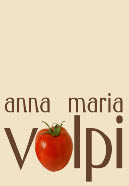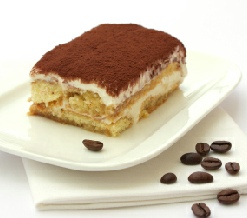



JOIN NOW
our Italian Cooking
Newsletter
our Italian Cooking
Newsletter









Publication or use of pictures, recipes, articles, or any other material form my Web site, on or off-line without written permission from the author is prohibited. If you would like to use my articles on your Web site or in your publication, contact me for details. Avoid infringing copyright law and its consequences: read the article 7 Online Copyright Myths by Judith Kallos
Read our
DISCLAIMER and
PRIVACY POLICY
before using
our site
-------------------
Linking Policy
Advertise with us
DISCLAIMER and
PRIVACY POLICY
before using
our site
-
Advertise with us
Copyright © 2003 - 2011 Anna Maria Volpi - All Rights reserved.
Anna Maria's Open Kitchen Site Map
site map
recipes
policies
about us
Some More Hot Topics You'd Like to See adv.
All About TIRAMISU’

A TRIP TO TREVISO, WHERE TIRAMISU WAS INVENTED
\Visiting “Le Beccherie” an Interview with Mr. And Mrs. Campeol
\Visiting “Le Beccherie” an Interview with Mr. And Mrs. Campeol
All About TIRAMISU
Everything you want to know about this celebrated Italian dessert
Everything you want to know about this celebrated Italian dessert
Tiramisu with Mixed Berries
A Tiramisu’ recipe has become a new classic
A Tiramisu’ recipe has become a new classic
Duomo Tiramisu
A special Tiramisu Dome shaped like a Tuscan Zuccotto
A special Tiramisu Dome shaped like a Tuscan Zuccotto
Crespelle Tiramisu
Delicious Crepes filled with Tiramisu’ cream and topped with raspberries
Delicious Crepes filled with Tiramisu’ cream and topped with raspberries
Crema di Zabaione
Enjoy this excellent classic Venetian custard easy to prepare
Enjoy this excellent classic Venetian custard easy to prepare





Original TIRAMISU of “Le Beccherie”
The first recipe for Tiramisu’ ever published in 1981 in Verona, Italy
The first recipe for Tiramisu’ ever published in 1981 in Verona, Italy
ANNA MARIA’S TIRAMISU
The Tiramisu’ recipe Anna Maria is proposing using safe ingredients
The Tiramisu’ recipe Anna Maria is proposing using safe ingredients






TIRAMISU’ CHARLOTTE
The Tiramisu’ takes a new shape
The Tiramisu’ takes a new shape


Anna Maria Suggests
Extra-
The Best Selection of Italian Extra-
Buy from the source Authentic Aged Traditional Balsamic Vinegar from Italy
Sicily, Apulia, Lazio, Liguria, and More...The Best Selection of Succulent Italian Olives Oil
Infused Extra-
Spice up your dishes with Infused Flavored Italian Extra-
I was in Italy at the time. A friend of mine told me about this new cake recipe she got. She was so enthusiastic about it that I felt compelled to try it immediately. The taste was unbelievably good, as I had never tasted before. Since then, I have been in love with this dessert.
Everybody knows by now that Tiramisu’ means “pick-me-up” in Italian, named for the high energy content (eggs and sugar) and the caffeine of the strong espresso coffee. There are many different stories about the origin of Tiramisu’. It is a layered cake, so some people place its origin in Tuscany, where another famous layered Italian dessert is very popular. It is called “Zuppa Inglese” (English Soup). It is neither English nor a soup. It is a simple cake of ladyfingers or a sponge cake soaked in “alkermes” liquor with alternating layers of chocolate and egg custard.
Layered cakes have been around for a long time. The brilliant idea in Tiramisu’ is not in the technique of layering, but in the components. It was a great idea to combine coffee, zabaglione cream, and chocolate together. This is the true innovation of Tiramisu’.
I love to study the history of food. In my book The Timeless Art of Italian Cuisine – Centuries of Scrumptious Dining, there is extensive information about the culinary history of the Italian regions. I tried to trace the origin of Tiramisu’ by investigating Italian cookbooks.
Everybody knows by now that Tiramisu’ means “pick-
Layered cakes have been around for a long time. The brilliant idea in Tiramisu’ is not in the technique of layering, but in the components. It was a great idea to combine coffee, zabaglione cream, and chocolate together. This is the true innovation of Tiramisu’.
I love to study the history of food. In my book The Timeless Art of Italian Cuisine – Centuries of Scrumptious Dining, there is extensive information about the culinary history of the Italian regions. I tried to trace the origin of Tiramisu’ by investigating Italian cookbooks.
Open an old Italian cookbook, browse through the index and… surprise! There is no Tiramisu’ cake recipe. My first encounter with Tiramisu’ was in 1985.
The History of
Tiramisu’ Cake
-----------------------------------
Where and How this
Famous Dessert was Invented
Tiramisu’ Cake
-
Famous Dessert was Invented
The first clue is by the famous Italian gastronome Giuseppe Maffioli. In his book Il ghiottone Veneto (The Venetian Glutton) first published in 1968, he talks extensively about zabaglione custard. The name of this cream originates from Zabaja, a sweet dessert popular in the Illiria region, a coastal area across the Adriatic Sea that was Venetian territory for long time during the golden age of the “Repubblica Serenissima” (“The Most Serene Republic”) of Venice. Zabaglione was prepared in those times with sweet Cyprus wine.
“The groom’s bachelor friends,” says Maffioli, “at the end of the long wedding banquet, maliciously teasing, gave him a big bottle of zabajon before the couple retired to guarantee a successful and prolonged honeymoon.” “The zabajon,” Maffioli continues, “sometimes had whipped cream added, but in this case was served very cold, almost frozen, and accompanied by baicoli, small thin Venetian cookies invented in the 1700’s by a baker in the Santa Margherita suburb of Venice.” The combination of added whipped cream, the serving temperature, and the cookies are close to the modern Tiramisu’ recipe. And even the allusion to the energetic properties of the zabaglione seem to refer to Tiramisu’s name.
Later in my research, the oldest recipe I could find was in a book by Giovanni Capnist titled I Dolci del Veneto (The Desserts of Veneto). The first edition was published in 1983 and has a classic recipe for Tiramisu’. Capnist writes that tiramisu’ is “a recent recipe with infinite variations from the town of Treviso” and a “discovery of restaurants more than family tradition.”
But the final word on the origin of Tiramisu’ is from a book by Fernando e Tina Raris named La Marca Gastronomica published in 1998. It is a book entirely dedicated to the cuisine of Treviso. The authors remember what Giuseppe Maffioli wrote in an article in 1981: “Tiramisu’ was born recently, just 10 years ago in the town of Treviso. It was proposed for the first time in the restaurant Le Beccherie. The dessert and its name immediately became popular, and this cake was copied by many restaurants first in Treviso, then all around Italy.”
The restaurant “Le Beccherie” still makes the dessert with the classic recipe. They use ladyfingers soaked in bitter strong espresso coffee, mascarpone-zabaglione cream, and bitter cocoa powder. Alba and Ado Campeol, the owners of the restaurant, regret not having patented the name and the recipe to avoid all the speculation and guessing about the origin of this cake and the diffusion of so many recipes that have nothing to do with the original Tiramisu’.
I have tried countless different recipes among the infinite variations of Tiramisu’, but the classic one, the recipe from Le Beccherie restaurant (the recipe I show on my website), is still the one I prepare today and the one I prefer. The original recipe includes the use of raw eggs. In order to avoid the danger of salmonella, I made a few necessary variations.
As an example of one of the many delicious variations of Tiramisu’, I am posting a step-by-step recipe for Tiramisu’ with Mixed Berries, which is quickly becoming a new classic.
Anna Maria Volpi
November 20, 2003
© 2003, Anna Maria Volpi
“The groom’s bachelor friends,” says Maffioli, “at the end of the long wedding banquet, maliciously teasing, gave him a big bottle of zabajon before the couple retired to guarantee a successful and prolonged honeymoon.” “The zabajon,” Maffioli continues, “sometimes had whipped cream added, but in this case was served very cold, almost frozen, and accompanied by baicoli, small thin Venetian cookies invented in the 1700’s by a baker in the Santa Margherita suburb of Venice.” The combination of added whipped cream, the serving temperature, and the cookies are close to the modern Tiramisu’ recipe. And even the allusion to the energetic properties of the zabaglione seem to refer to Tiramisu’s name.
Later in my research, the oldest recipe I could find was in a book by Giovanni Capnist titled I Dolci del Veneto (The Desserts of Veneto). The first edition was published in 1983 and has a classic recipe for Tiramisu’. Capnist writes that tiramisu’ is “a recent recipe with infinite variations from the town of Treviso” and a “discovery of restaurants more than family tradition.”
But the final word on the origin of Tiramisu’ is from a book by Fernando e Tina Raris named La Marca Gastronomica published in 1998. It is a book entirely dedicated to the cuisine of Treviso. The authors remember what Giuseppe Maffioli wrote in an article in 1981: “Tiramisu’ was born recently, just 10 years ago in the town of Treviso. It was proposed for the first time in the restaurant Le Beccherie. The dessert and its name immediately became popular, and this cake was copied by many restaurants first in Treviso, then all around Italy.”
The restaurant “Le Beccherie” still makes the dessert with the classic recipe. They use ladyfingers soaked in bitter strong espresso coffee, mascarpone-
I have tried countless different recipes among the infinite variations of Tiramisu’, but the classic one, the recipe from Le Beccherie restaurant (the recipe I show on my website), is still the one I prepare today and the one I prefer. The original recipe includes the use of raw eggs. In order to avoid the danger of salmonella, I made a few necessary variations.
As an example of one of the many delicious variations of Tiramisu’, I am posting a step-
Anna Maria Volpi
November 20, 2003
© 2003, Anna Maria Volpi
